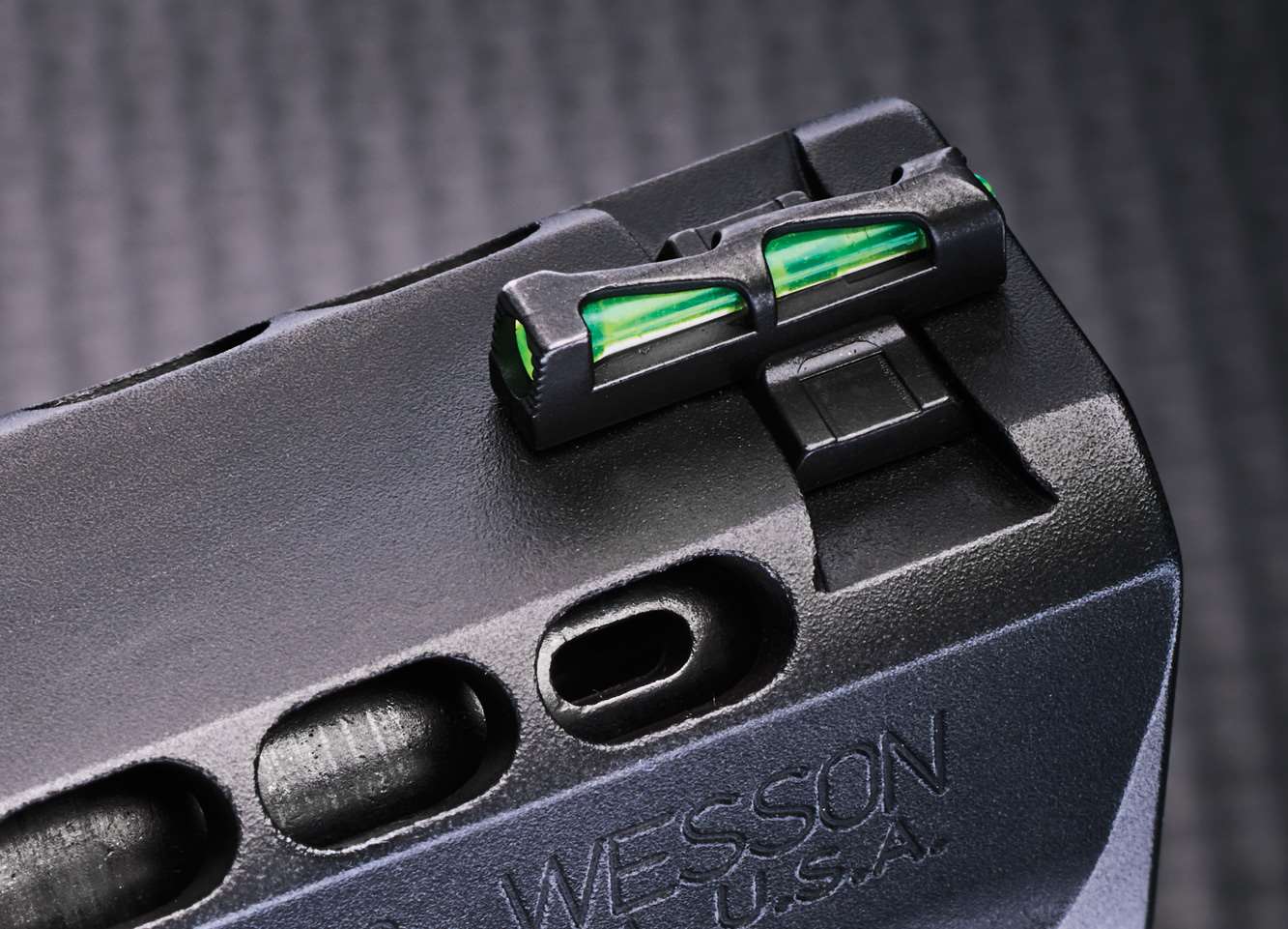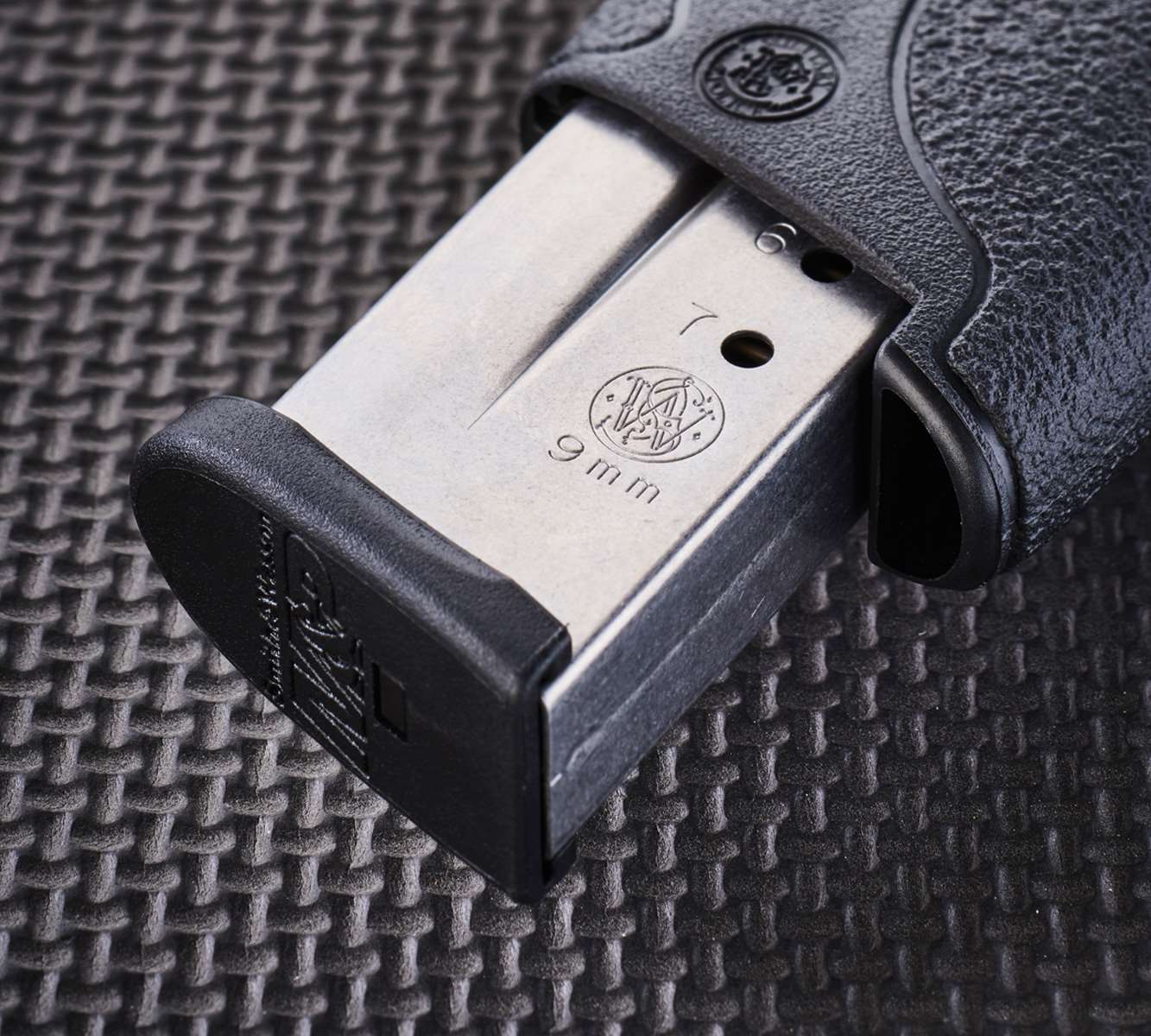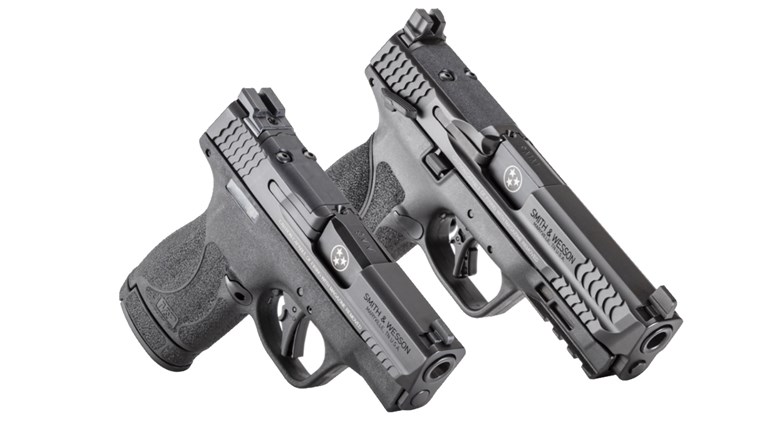
This feature appears in the June ’16 issue of NRA America’s 1st Freedom, one of the official journals of the National Rifle Association.
Carry-class pistols abound at present, but few indeed get as many things right as this 9 mm from the company’s famed Performance Center.

We grant that out-of-the-box Smith & Wessons have set the bar high for generations of shooters and in many applications. As if that were not enough, the company’s Springfield, Mass., Performance Center has been the place where any remaining shortcomings—however rare—have gone to die. In a separate shop, Smith’s master gunsmiths overlay their art back on state-of-the-art engineering, materials and design. Not coincidentally, this is where our Shield hails from.
A slight disclaimer here: The Shield is already our favorite M&P. We like the larger versions just fine, mind you, and for a bunch of reasons: Stock triggers are a vast improvement over previous generations of striker-based actions, and excellent grip design is a comfort-and-control boon to many shooters. The operational dynamics of the larger M&Ps are superb, too—fine balance in one-off, high-precision shots is complemented by a low-bore axis that gobbles up recoil. There’s a reason you see M&Ps almost everywhere—USPSA, IDPA, 3-Gun, Steel Challenge, to say nothing of widespread law enforcement adoption. You get the idea.
Bringing all this to the modest dimensions of the Shield is a further masterstroke. Carry-class pistols have long sacrificed so much for their small footprint that they were barely worth the trouble. Not that long ago, it was common for such guns to be relegated to marginal defensive calibers as well—.380 ACP (or 9x17/9 mm Kurz) was the best that could be hoped for. (It’s only recently that ammunition improvements have, to an important extent, rehabilitated .380 ACP for defensive applications in pistols like the S&W Bodyguard.)There’s a reason you see M&Ps almost everywhere—USPSA, IDPA, 3-Gun, Steel Challenge, to say nothing of widespread law enforcement adoption.
Those limitations, we submit, are now a thing of the past. What the original Shield subdued in fine handling characteristics and ultra “carryable” dimensions, the next-step Performance Center version pretty much pulverizes.
When you pick up a Shield, one of the best features may be readily apparent, though it’s a favorite of long standing in our book—HiViz fiber optic sights. To many, these are nothing new. But if you have any trouble picking up your sights or tracking them through recoil, it can be astonishing how much these aid the recovery of sight picture. Since most Shields are destined for defensive or carry purposes, advantages compound for these smaller, inevitably “buckier,” pistols. If this is a gigantic “huh,” just wait until a few more pages come off your personal calendar—eventually, you’ll like those ultra bright fibers front (green) and rear (two red) as much as we do.
Other goodies that make the Shield so superb are inside the pistol. Virtually all striker-fired designs have a plunger that is part of a trigger-activated safety system. Ditto, a sear, or some proxy for a sear: This part releases the striker (think “firing pin”—similar function, different mechanics, sometimes including a hammer) from the control of the trigger itself. While both are essential, they’re also infamous as a source of grittiness and weight variation in the feel of any trigger.
Here the Performance Center jumps in, as the saying goes, with both feet. Much like an after-purchase trigger job, the plunger and sear are precisely fit to the specific Shield in which they are installed. The benefit is simple, at least in conception: The micro-imperfections that exist in any metal surface are reduced or eliminated in these parts to the point that they add vanishingly small friction to the firing system. Only the forces necessary to shock the primer into flashing and provide safeties remain in play.

Out of the box, the results are worth the effort—it’s hard to imagine a safer, more controllable, more reliable trigger, and particularly in a pistol scaled like the Shield. As expertly worked triggers often are, our Performance Center trigger was clearly better than the “spec” 6.5 pounds after a short break-in. It measured 5.5, and felt/functioned more like 4.5.
But it’s on the range the final difference in the Shield really comes into its own. Those three-per-side cuts through the slide at the “10:30” and “1:30” positions just behind the front sight don’t merely look slick, but they actually bring to the little M&P some of the best recoil control technology available.
Closer inspection of an in-battery pistol makes clear why: Under the front set of slide cuts are matching barrel cuts, technically “ports.” A variation on a method long employed to reduce recoil in everything up to artillery, the ports “jet” combustion gases behind the departing projectile. Out of the box, the results are worth the effort—it’s hard to imagine a safer, more controllable, more reliable trigger, and particularly in a pistol scaled like the Shield.
The net result is a docile, accurate joy. From run-of-the-mill 115- and 124-grain “target” loadings to esoterics at both ends of the spectrum (90- and 158-grain), we experienced not one malfunction. Our test outings for the Shield were small in number, but surprisingly long, and they signal another very desirable trait: When your defensive pistol doesn’t beat you up, you’ll soon come to enjoy practicing with it. And if you practice with it, exemplary skills are sure to follow.
We doubled down on this comfort factor, and shot the Shield a good deal in unconventional scenarios. These included extensive one-handed drills (both strong and weak hand) and other hand positions we’d group as “difficult.” Some of these are intentionally, deliberately faulty and intended to excite malfunctions, and they routinely succeed with lesser pistols. Marking that “lesser,” you can predict our results: The Shield sailed through these as well.
We end with a potentially unhappy revelation, at least for some. Even when assessed against many full-sized handguns, the “carry” M&P is an impressive achievement; and against most of its class competitors, it simply isn’t a fair fight. If we haven’t made that clear, don’t blame the pistol. So whether it’s as a “shield” for cherished loved ones, or a continuing “shield” for the fine Smith & Wesson reputation—164 years and counting—the Shield vaults most any bar with ease.
NUTS AND BOLTS:
In considering Smith & Wesson’s Shield, a comparison with another major player in the 9 mm/discreet carry arena is unavoidable. Ergo, we won’t: How does the Shield compare to the very similar—in footprint, weight and caliber—Glock G43?
First, we acknowledge the comparison as slightly skewed since the ported Shield has that engineered-in advantage, as well as better sights. MSRPs, however, imply equality, and we proceed on that basis.
The 9 mm recoil is not revoltingly sharp in either of these and reflects their thoroughly modern designs. Both have low or very low bore lines (very slight advantage Glock here), and ideal recoil spring rates—we assert zero malfunction rates for both pistols as ample evidence that both are perfectly sprung. The net result is a docile, accurate joy. From run-of-the-mill 115- and 124-grain “target” loadings to esoterics at both ends of the spectrum (90- and 158-grain), we experienced not one malfunction.
We also found both far more practically accurate than we would have expected given the relatively short sight radii (G43, 5.2 inches, Shield, 5.3 inches). At defensive ranges, both are standouts: Classic “failure to stop” drills are just plain easy, and “just ’cause we can” shots to 50 yards were routinely possible with both.
Triggers remain a gargantuan matter of taste. We think both resolve to “very good” with practice, though you’ll never confuse either with a 1911-style bull’s-eye rig.
If it sounds like we’re edging up to a cop-out, perhaps we are. Both these pistols are so much better than generations of predecessors that we get uncomfortably close to calling any slight preference a superiority, and that helps no one. Resigned to being pelted with grouchy mail, we default to recommending that you shoot them both and make your own decision based on how their ergonomics match up with yours. We have vast confidence in either.


































